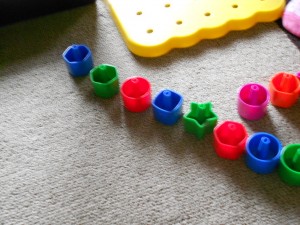Flat glass marbles, like these in a grown-up friend’s fairy garden, inspired some fairy math fun and play counting, grouping, and making patterns.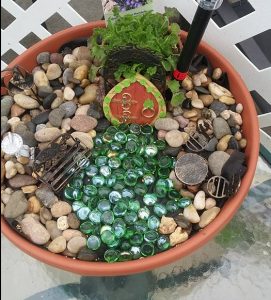
In the craft drawer, we have a few of these smooth, sparkly glass circles left-over from another project. They make wonderful fairy rocks. Big Brother, who is just 4, likes to count. He counted these several times. Each time he counted he got a different number, because he skipped a number here and there.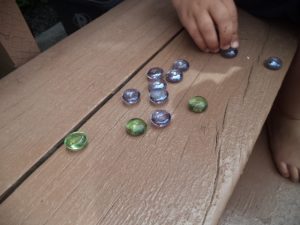
Accurate counting comes from practice; just remembering all the numbers is quite a challenge, never mind getting them in the right order. He did touch each marble as he said a number, showing that he has figured out each number goes with one item. This one-to-one correspondence is the foundation for counting, that one number is connected to one thing. As we say more numbers, we mean more things.
While he was counting, Big Brother noticed there were different colors. He liked the green ones so he separated them from the light purple ones. Making groups is a powerful thinking skill. As we think, we organize and deal with information. Do you remember the movie, “Honey, I Shrunk the Kids?” Grouping or categorizing is like the movie; it shrinks information into smaller packages.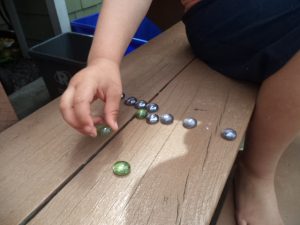
Making patterns is another way to shrink information. If the fairy rocks are in random order, it would be hard to remember the color of each one. If there is a pattern, such as purple rock – green rock, purple rock – green rock, it’s so much easier.
With the fairy rocks, I showed Big Brother a purple-green, purple-green pattern. He wasn’t interested in having a pattern. He just wanted the green ones. Again, patterning is a skill that kids develop from experience and practice. There will be other opportunities to show simple patterns until the brain makes the needed connections.
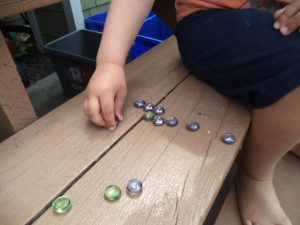 For most of this fairy math fun, Big Brother directed the play as he wanted. He liked making a line and different shapes. After a while, he decided to do something different. We carefully put the fairy rocks away so Little Brother didn’t get them. Do you have any items that could be fairy rocks for some math fun and play?
For most of this fairy math fun, Big Brother directed the play as he wanted. He liked making a line and different shapes. After a while, he decided to do something different. We carefully put the fairy rocks away so Little Brother didn’t get them. Do you have any items that could be fairy rocks for some math fun and play?
For more fairy play activities, check the plays-of-the-day on the blog.

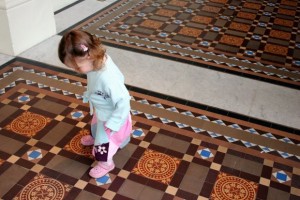

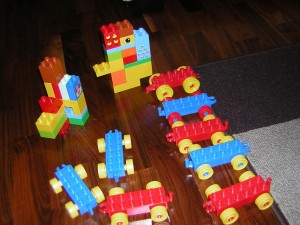 When a 3-year old was playing trains, I lined up a few cars in a simple pattern: red-blue, red-blue. I said each color and pointed to the cars. I spoke to the train cars and told them they were making a pattern, first red then blue, then red and blue again. Then I asked the child what color would come next and together we figured out a red one. The child was able to say blue would come after that but then playing changed to putting blocks on the cars.
When a 3-year old was playing trains, I lined up a few cars in a simple pattern: red-blue, red-blue. I said each color and pointed to the cars. I spoke to the train cars and told them they were making a pattern, first red then blue, then red and blue again. Then I asked the child what color would come next and together we figured out a red one. The child was able to say blue would come after that but then playing changed to putting blocks on the cars.
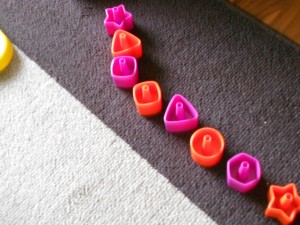
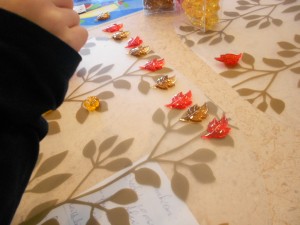
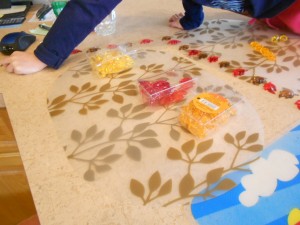 When that pattern was done, I tried one more complicated using pairs: two pumpkins/two acorns, two pumpkins/two acorns. This is an AABB sequence, quite a bit more complicated. Little Sister looked at it but said it wasn’t a pattern. Her mind could see the simple one but wasn’t yet ready for something harder.
When that pattern was done, I tried one more complicated using pairs: two pumpkins/two acorns, two pumpkins/two acorns. This is an AABB sequence, quite a bit more complicated. Little Sister looked at it but said it wasn’t a pattern. Her mind could see the simple one but wasn’t yet ready for something harder.